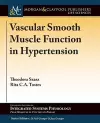
Vascular Smooth Muscle Function in Hypertension
2 authors - Paperback
£43.95
Theodora Szasz was born and brought up in Romania. She received her M.D. from the Iuliu Hatieganu University of Medicine and Pharmacy in Cluj-Napoca, Romania, and her Ph.D. in microbiology and molecular genetics from Michigan State University, East Lansing, Michigan. Her interest in smooth muscle function began with her graduate work, which was completed under the supervision of Dr. Stephanie Watts in the Pharmacology and Toxicology Department at Michigan State University. During her Ph.D., Dr. Szasz studied the role of reactive oxygen species in modulating venomotor tone during hypertension. Dr. Szasz is now a postdoctoral fellow in the Physiology Department at Augusta University, where she works with Dr. Clinton Webb. Her main research interest is integrative cardiovascular physiology, with a focus on the physiology and pharmacology of smooth muscle, as well as the correlations between risks for cardiovascular disease (hypertension, obesity, diabetes) and mechanisms of vascular dysfunction. Rita C. Tostes was born in Brodowski, in the Southeast of Brazil. She received her Ph.D. in Pharmacology at the Ribeirao Preto Medical School, University of Sao Paulo. She was introduced to cardiovascular research by Professors Lusiane M. Bendhack and Ana Maria de Oliveira, in Brazil. Her training in vascular physiology and pharmacology included the mentorship of Professors R. Clinton Webb (Augusta, Georgia), Maria Helena Carvalho (Sao Paulo, Brazil), Ernesto L. Schiffrin (Montreal, Quebec), and Rhian M. Touyz (Glasgow, Scotland). With them she discovered the exciting world of cellular and molecular mechanisms involved in the regulation of vascular function under physiological and, particularly, under pathological conditions. Her research group investigates the mechanisms causing vascular dysfunction in cardiovascular and metabolic diseases. She has a special interest in the role of sex hormones, aldosterone, endothelins, and the immune system in the development and progression of arterial hypertension and in the complications associated with diabetes and obesity.